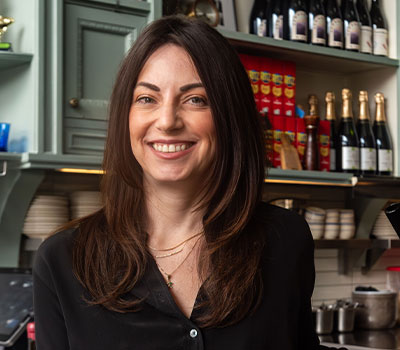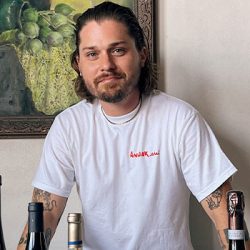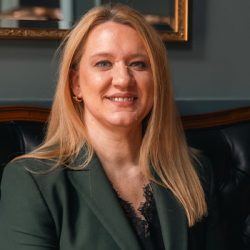Evelyn Goreshnik was working as the GM at Alimento, chef Zach Pollack’s Italian spot in the Silver Lake district of Los Angeles. “That’s where I got to really understand what good natural wine meant,” she says. “Clean, beautiful natural wine—it was done in a way that wasn’t dogmatic, just pretty and well balanced. Having that kind of a foundation for someone new to the wine world was such a great thing.” Now Beverage Director at Barra Santos in Cypress Park, Found Oyster in East Hollywood, and six other Last Word Hospitality restaurants, Goreshnik covers much of the globe in her programs, but is most excited about introducing her guests to the wonderful wines now available from Portugal. —David Rosoff


What kinds of wine have recently caught your interest?
I really enjoy lower-ABV wines. Because of the world I’m in, there’s moments where I’m tasting and drinking so many different wines that I personally love something like a slightly lower-ABV riesling that’s dry, or maybe has a tiny bit of residual sugar and isn’t so aggressive on my palate. And I can enjoy it throughout an entire meal, too. At Barra Santos, I pour a Vinho Verde from Asnella. I believe that’s 12 percent ABV. A lot of the whites can go down to ten to eleven.
Recently, I’ve really discovered a big love for Portuguese wine. The work that I do at Barra Santos has really opened that door for me and they’re making such incredible wines at such incredible price points. I’m honestly surprised not to see it in more places. I know it’s getting there and it’ll probably keep building. I wish I could have more options to pull from. It’s been such a beautiful experience to work with so many Portuguese wines within the last year. And I have to say, I don’t think a lot of people do that with the depth that I’ve been doing it. Spain now feels like Burgundy. To the guest, Spain is like, ‘Oh, wow, Spanish wine. What a treat.’ With Portugal, I’m going over varieties that no one understands.
There’s so many amazing producers in Portugal. Quinto do Santiago from Vino Verde; Filipa Pato; Luis Seabra. Alvarinho is stunning. When we taste them during pre-shift, blind, a lot of people would assume that these are white Burgundy. They’re really compelling wines, and the price point is never so aggressive that anything has to be over 200 dollars on a list.
What categories do you focus on most for the restaurants?
Each venue is so different. We sell a ton of skin contact; they are on an upward trajectory. Those are the ones that are constantly needing to be replenished. It takes a lot of work to find affordable skin contact that you can pour by-the-glass. There’s a lot of beautiful, expensive orange wine that I have on my list. However, those aren’t moving as much. It’s really about finding the beautiful skin-contact ones that are under 20 dollars that you can pour and actually reorder. I pour the Wavy Wines from Jude at Found Oyster for 15 dollars a glass. And I love the Kabaj wines. Within the last year reordering has gotten a lot trickier. I have to be really creative and have two, three wines lined up to sub out.
Also, within the group, chilled reds move and do really well, even if it’s a seafood-based restaurant. There are those people who still want red wine with their oysters, and we have to give it to them.
What new category or region did you add this year that got the most traction?
I would have to go back to Portugal. They do a lot of really interesting red-and-white field blends that I’ll categorize as a lighter red. I try to put it where I think it’ll move better. And I find putting it as a light chilled red really moves it along a little bit easier than, say, a really deep rosé.
It’s interesting that you say that because there is now a fifth color. There’s white, red, pink, orange, and now there’s the field blends of white and red grapes. And where do you put them on a list?
With these wines, there may be 20 red varieties in the blend and 20 whites. It’s as much a white wine as it is a red wine. For me, it works best as one of the first few reds mentioned because it’ll be the lightest. Even though it’s technically not red, it’s going to move because it’s a lighter-looking red wine. And also, creating a new category for people just creates more confusion.
What was the most exciting bottle for you to sell this year?
The old-vine Tapada do Chaves at Barra Santos. It’s the most expensive bottle on the list, but it’s also one of the more compelling whites Portugal is releasing to the United States. These are 120- to 160-year-old vines; blind, you would think that it’s white Burgundy if you didn’t know any better. And it’s so special. And Quinta Edmun do Val. I had the good fortune of getting the 2008 bottling of the Alvarinho Vinho Verde Grande Reserva. It’s such a complex alvarinho. This is what we would consider similar to really beautiful high-end chenin. And it’s a price point that is incredibly friendly versus some of the prices we pay for French. A lot of things are getting priced out, where you’re not able to drink the kind of Italian and French wines you want to. High-end wines, after a certain price point, may be losing ground. I think right now with everything that’s happened within the last three years, we’re still not there.
In 1993, Los Angeles native David Rosoff left the music business to launch his wine and restaurant career. He has managed and run the wine program at Los Angeles institutions Michael’s and Campanile, and was a founding partner at Pizzeria Mozza, Osteria Mozza, Chi Spacca, Triple Beam Pizza and Hippo. In a Los Angeles Times profile, Patrick Comsikey had this to say: “Rosoff is like wine royalty in Los Angeles. He’s managed wine programs at i Cugini, Michael’s, Opaline, Campanile and most significantly perhaps at the Mozzaplex, where, with his all-Italian wine lists, he gently taught diners not to fear what they could not pronounce, or recoil from varieties produced in regions they’d never heard of, but rather to fall in love, as he did... If this city has a wine consciousness, Rosoff is one of its principal catalysts. He is like a vinous municipal treasure.”
This story appears in the print issue of February 2024.
Like what you read? Subscribe today.




















